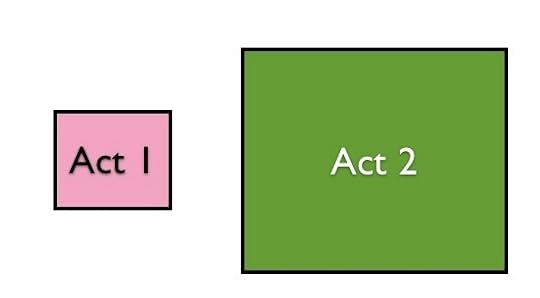Rajesh Setty's Blog, page 11
October 12, 2012
From an Expert to a Guru | Interview with Mitchell Levy
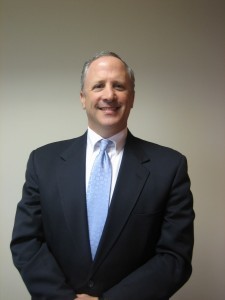 Mitchell has been a close friend for more than a decade. A few years ago, we both became business partners in a book publishing venture called THiNKaha. It has been a wonderful journey so far. Over the last decade, Mitchell has been helping hundreds of experts go from being an expert to being a Guru. Here is a quick interview with him on what it takes to make that switch.
Mitchell has been a close friend for more than a decade. A few years ago, we both became business partners in a book publishing venture called THiNKaha. It has been a wonderful journey so far. Over the last decade, Mitchell has been helping hundreds of experts go from being an expert to being a Guru. Here is a quick interview with him on what it takes to make that switch.
RS: Mitchell, first – why should someone think of being a Guru?
The name “guru” is not as important as what the name implies. Whether you call yourself an expert or a guru doesn’t matter. What does matter is being recognized in your target market as one of the key “go to” people in the space you are in. It’s easy to think about what the word expert means. You are an expert when you know a relatively large amount about a subject — as much as others in the space. You are a guru when others recognize you as the expert in your space and seek you out for your help. Closing new business is much easier when clients come to you.
RS: What does it REALLY take to go from being an expert to being a Guru?
There are four things you need to do to transition from expert to guru and you need HELP to make that happen:
• H is for a healthy following. You not only need to be an expert, but you need to have a number of people that follow you and not only know that you are an expert, but seek out your expertise.
• E is about execution, you need to execute well. Every time you interact with folks whether it’s speaking, consulting, or just delivering on any promise, you need to execute well. You need to deliver on your promises and ensure that your deliver on the implied benefit of your brand (see #MY BRAND tweet ).
• L is for thought leadership. As you learn more, grow and deliver on your brand promise, you need to share that wisdom with others. Books are the best form of thought leadership, but there’s also TV, radio, blogging, magazine columns, webinars, video and audio tapes, etc. There are many forms of thought leadership and you need to continue to create and share as much as you can (see #THOUGHT LEADERSHIP tweet ).
• P is for platform. You need to have a robust platform that you use to share your thought leadership, knowledge and your continuous learning. It’s important to keep stoking the fire and to continue to attract more followers who are interested in knowing what you are doing.
RS: What are three things that an expert can do starting tomorrow to begin that journey?
1) Clearly define and articulate your market. Make it as narrow as possible. Know who is in it and what services you can deliver to reach and affect that market.
2) Identify and start making friends with the thought leaders in your space and try your best to do favors for them. Comment on their blogs, retweet their tweets, introduce them and share their thought leadership with others.
3) Define and put a plan in place to give yourself month-to-month HELP. That plan should include: a) setting up media engagements, b) writing/crowdsourcing one or more books, and c) allocating time each day to touch key folks in your field.
RS: Can you share a couple of your new initiatives that can help experts in this journey?
The Gurus4Media web site is a free service that will allow you to find places to share your wisdom with the world. Please sign up and use it. There is also a set of vetted paid-for services including radio tours, blog writing, social media, Webinar support, marketing, and strategic consulting that you can take advantage of: http://gurus4media.com/expert2guru-services
The best form of thought leadership is a book. Most of us don’t have 1,000 hours and 2-3 years to make that happen. That’s why we have a THiNKaha series where you can crowdsource your book in as little as 20 hours. If you have no time, our team can ghost write it for you. As you know, having a book will be the best calling card you ever create.
RS: Are there any tools you want to share for free right now?
Yes, of course. First of all, please go and sign up at Gurus4Media (http://gurus4media.com). You can find media interested in you speaking on the air and writing on their platforms. You can also find other experts interested in writing in your platform.
There are two ebooks I’d like to share: “42 Rules for Driving Success with Books” and “#CROWDSOURCING tweet” by our common friend Kiruba Shankar. Please go to those urls, click on the purchase eBook button and in the coupon code field, please type in “Author”. After clicking on update, the cost will go to zero so you can download the ebooks for free.







October 10, 2012
Follow the Instructions!
I have seen this a few times on Facebook. This time I couldn’t resist capturing the image to make a point.
In this image below, there is the photo of a man standing on the ledge with a bear right near him. The text accompanying the image urges the readers to click on the image, type “Jump” in the comment box and then watch what happens.
What do you think should happen?
Nothing.
Right – because whatever you type in the comment box will have ZERO effect on the image. You can’t trigger anything on the image by posting on the comment box.
Of course, that would be too logical.
When I took the screenshot, there were 23,000+ comments most of which typed the word “Jump” in the comments box. For every 25 or so “jumps,” one or two people would try to expose (?) the silliness by typing “nothing happens here” or something like that. But even after that, hundreds of people continue to type “jump” in the comment box.
Honestly, most people know that there is nothing that’s going to happen when the type “jump” in the comment box. But somewhere deep in their mind, they think – “What if something does happen.. the cost of checking that is super small. All I have to do is type jump in the comment box…”
To make things worse, they see tens of thousands of people who have typed “jump” (social proof) compelling them to go for it.
What we need to reflect is not whether we were one of those that fell for the trap above but where else in our life are we following instructions blindly just because the cost of following them is very small.
All the best!
PS: Here is one other example with a lot more people following “instructions.” Keep smiling.







October 7, 2012
Mini Saga #126 – Artist
Mini Saga #126 – Artist
Frank was an artist. At least he thought he was. Four years, nothing had worked. Concerned, his friend Jim asked him, “Do you fear that nothing might click for the next few years?” Frank nodded. “So, how will you address that fear?” Jim asked. Frank smiled, “By creating more art…”
It takes time to get good at your craft. Until you do, nothing might click. Fear that nothing might ever click will keep lingering in your head. People around you will put more fuel to that fear. The only way to overcome that fear is by creating more art. The magic is not when that fear disappears but when you can create more art in the face of that fear.
Note:
1. A mini saga is a story told in exactly 50 words. Not 49 or 51 but exactly 50.
2. You can download a photographic manifesto of Mini Sagas at ChangeThis. Here is the link – Mini Sagas: Bite-sized Wisdom for Life and Business (PDF, 2.9MB).
3. For a complete list of Mini Sagas, please see the entire list here or at Squidoo.







October 6, 2012
Act 2
They discovered you. Now what?
The web is filled with articles about how to get attention. From SEO tricks to paid traffic there are hundreds of ways to get attention today. Unfortunately that’s not the end, it is the means to an end.
For me, getting discovered is Act 1.
What happens immediately after getting discovered is Act 2.
If you have an A+ in your Act 1 and if you have a B- in your Act 2, you risk losing someone and their network for some time to come.
Let me explain.
Act 2 is what you really bring to the table – the positive possibilities for the future of the person in question. It’s your ability to make a meaningful difference in the lives of the people who discovered you. It is where you move the needle. The real impact is always relative – what you bring is always compared with what could be got by choosing the best among other available options to the person or organization in question.
Act 1 is the means to an end to your Act 2.
Your Act 1 is where you promise and your Act 2 is where you deliver on that promise.
Your Act 1 is where you raise your hand and attract attention and your Act 2 is where you lend a helping hand.
Your Act 1 is how you are perceived and your Act 2 is where the reality hits.
Your Act 1 is your focus on your marketing and your Act 2 is where you make meaning happen.
Your Act 1 is telling about your craft and your Act 2 is THE craft.
As counterintuitive as it sounds, if you relentlessly focus on being a master at Act 2, succeeding in your Act 1 costs you less. Succeeding in Act 2 requires you to invest in yourself to make a bigger difference. Not once, not twice but every single day.
I am not suggesting that you should not focus on your Act 1 but Act 1 should be more about amplifying your Act 2. If Act 2 is solid, amplifying it will cost less. If Act 2 is weak, engaging in Act 1 takes more effort and takes your precious time away from focusing on Act 1 and further takes you down a vicious cycle.
This weekend may be you can take a few minutes to reflect on your Act 2. It will be well worth your time!







September 30, 2012
How to set the right context to add more power to your story
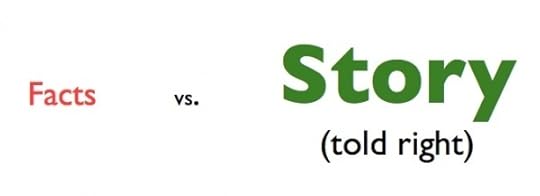 In storytelling, this is generally called an exposition, a space where you share the lay of the land. In a world where everything moves in a breathtaking speed, it is not uncommon to skip the context and get RIGHT TO THE POINT. You might have been tempted to do it yourself time and again. Your justification would be that everyone is pressed on time and you are doing them a favor by getting right to the point.
In storytelling, this is generally called an exposition, a space where you share the lay of the land. In a world where everything moves in a breathtaking speed, it is not uncommon to skip the context and get RIGHT TO THE POINT. You might have been tempted to do it yourself time and again. Your justification would be that everyone is pressed on time and you are doing them a favor by getting right to the point.
Let me share a real-life example to illustrate the power of setting the right context: I was at the ICC Annual Banquet yesterday (thanks to Diana Rohini LaVigne) which turned out to be simply an awesome program. One of the trustees, Venky Ganesan (partner at Globespan Capital Partners) spoke about a few accomplishments from ICC in the last year.
One of those accomplishments was that ICC sent three table tennis players to the most recent Olympics in London.
That sounds good but Venky did not stop there. He followed on with the story (paraphrasing) below:
“Well, let me go back to all it started. It seems like a Bollywood story. It starts with a young professional who comes to US for his higher studies. To keep the lights on, the professional starts working the graveyard shift at a gas station. There he meets a serial entrepreneur from the Valley and as they start talking they both realize that they have one thing in common – table tennis. That young professional is Rajul Sheth, now the head table tennis coach at ICC (interview link) and the serial entrepreneur is Anil Godhwani (interview link) who is one of the founders of ICC. Soon they both decide to bring table tennis in a big way to the valley and rope in people like Steve Westley (former Controller of California)
In a short span of time, the center has a thriving table tennis community and three people from the center go to the London Olympics. Now, some more context – India, a country with more than a billion people sends two players to the Olympics – one male and one female. US and Canada together send three people to the Olympics and all three people happen to come from ICC.”
Can you see the difference between the first version and the second version?
That’s the power of setting the right context in action.
Have a great week ahead.







September 29, 2012
The Inflection Point Around 40
When I wrote “Beyond Code” (foreword by one of my heroes Tom Peters) in 2005, my research was limited to technology professionals because that was my whole world. My thesis then (I still subscribe to that even today) was that for technology professionals to keep growing, they not only have to be good at “code” but also good at skills “beyond code,” else they will get into a stuck state by the time they are around 40 years old.
Fast forward seven years and I am now convinced that this thesis is applicable across industries.
Let me explain in a bit more detail:
In general, one will enter the world of work before he or she is 25 years old. Yes, there are exceptions but let’s talk in general terms for now. Unless someone is a genius, they have to start at the bottom of the career ladder where he or she has to learn the tricks of the trade and gain “experience” that will make them reach the next rung int he career ladder. Every promotion seems like a career milestone and seems like one is making progress. For the next 15 years or so, these promotions will happen in a certain frequency continuing to give assurance to the person that “progress” is indeed happening.
In parallel, there are life changes happening in the person’s life – marriage, kids, aging parents, buying a home, moving places, health issues here and there, adventures and misadventures and so on. In personal life, the person becomes equally or more accountable than the professional life. As the person gets more experienced, the capacity to perform increases but the capacity to take bold risks decreases because of what’s happening in the personal life.
Then around 40 – something happens. Boom! The person seems like he or she has hit a glass ceiling. Everything seems to come to a halt. In some cases, “work” seems monotonous and the growth is no longer in the horizon. The immediate response internally is that the person has become the victim of something (example: economy) or someone (example: the boss) and that needs to change for the person’s situation to change. Now we have an external dependency that is driving the internal happiness. Once this “blame that external factor” virus hits the person, there is no antibiotic that will take the person out of that condition.
Take a look at the following triangle (with a twist of course)
Think of the above is a typical career ascent triangle. At the bottom of the triangle there are TON of people similar skills – more importantly similar capacities to perform. As the person moves up the triangle, there are less and less people who are in that position of power. As the person moves closer to the top, the number of people decrease drastically. Around 40, the person has close to 15 years of experience and senior enough to take on some serious leadership position – a position where the needle can move one way or the other based on the person’s decisions. Those kinds of positions are “high stake” positions for the organization. The surprise for some is that how few those positions are in any organization. At the inflection point, the number of such positions shrink to disproportionately smaller numbers than what the person could have imagined.
Another surprise – what it takes to make the “jump” are skills and accomplishments (providing proof that the person is qualified) that should have been developed over the 15 years career and not something that the person can pick up overnight. So if the person does not make the “jump,” he or she is simply paying the price for the sum of all the “not so optimal” career decisions the person has made throughout his or her career.
The point: For those of you who are still young, know that the inflection point is coming sooner than later and revisit your every career decision from now on. For those of you who have crossed the inflection point, stop blaming the “external factors” as it’s a serious “cop out” strategy – you might as well take the lion’s share of the responsibility and make something happen in your second half of the career.
All the best!







September 20, 2012
Launching BLOGTASTIC!
I am excited to announce the launch of my book on blogging titled
BLOGTASTIC!
Growing and Making a Difference Through Blogging
It’s been 2775 days since I started blogging and this is blog post number 1805. It does seem like a long journey now that I think about it. However, I can tell you that the entire journey has been a fulfilling one.
Now, why did I stick with blogging for such a long time and continued to invest in it? For starters, here are five reasons:
1. Curiosity: My curiosity level about pretty much everything has gone up by a notch or two because of blogging. I just think, reflect and read more on topics that interest me.
2. Clarity: In general, writing increases your clarity because while your thinking can be garbled, you can’t extend that to the paper. Blogging is even better than writing because you are now writing in public.
3. Connections: I have had literally hundreds of people who got connected first through my blog and then slowly moved to become offline connections.
4. Contribution: My blog has provided me an amazing opportunity to scale. All of us have only 24 hours and are limited by the clock on the number of touch points in a day. With a blog, that restriction got lifted instantly.
5. Confidence: Since my blog also provides me an opportunity to beta-test my ideas and refine them, my confidence to pursue many ideas has gone up significantly.
I can think of more but the above reasons are already compelling enough for me to keep blogging. I have shared the lessons learned over these years and packaged them into the above-mentioned book.
Now, coming to the publishing of the book: There were many routes to take. Since I am involved in multiple publishing ventures, one easy choice was to get it published through one of them. In parallel, I was also thinking about Seth Godin‘s Unleashing the Idea Virus experiment about a decade ago where he gave away the book for free. Unleashing the Idea Virus was a book that people would have gladly paid to buy it but by giving it away for free, it probably reached a LOT more people.
As luck would have it, my friends at MobStac were looking to give a meaningful gift to bloggers. The book resonated well with the team there and my dream of giving away the book came true. Via two companies that I am involved with (Foresight Plus for strategy and ClickDocuments for content marketing) we went to work for the last two months to create something really compelling. We also reached out to more than 30 experts to share their insights on blogging and included them as well.
I am thankful and blessed to have the support of these contributors and the media partners who offered to help with the launch of the book. You can see the entire list of contributors and supporting media partners on the landing page.
A project like this impossible to pull off with one or two people. There are dozens of people who have spent days and weeks to make this a valuable contribution to the blogging community. I have listed all of them in the Acknowledgments section of the book.
You can download the FREE PDF here:
You can also get the light-weight (slimbook version) of the book through our partners SlimBooks (paid)
Get SlimBook version of BLOGTASTIC
Social Media Enabled Book: When you download the book, you will notice that the book is completely social media enabled – tightly integrated with Facebook, Twitter and LinkedIn. If you like the insights there, you can share them on the above-mentioned social networks with one-click. Please check that out.
If you have a blog or even if you are remotely interested in blogging, you will get something out of the book – now and for the future. Thanks to MobStac, the price point (FREE) for the book should make this a no-brainer to download. My hope and dream is to reach as many people as possible – so if you like what you read, please help spread the message and THANKS in advance for those who provide a helping hand.
Have a great Thursday.







September 11, 2012
Sarah Evans on [Re]Frame
A few days ago, my friend Kevin Madsen from SlimBooks sent me a copy of Sarah’s book Re[Frame] to get some comments. I told him that I would be on a plane on Tuesday and I would read it then. Kevin is smart and sneaky (in a good way) so he sent me a mail back asking me to just browse through the first 6-8 pages before Tuesday.
So, last Friday I started browsing through the book. In matter of minutes, I was hooked on the book. By the time I checked, I was more than half way through the book. It is one of those books I wish Sarah had written and published long ago. Now, it’s easier said than done. In my short conversation with Sarah, I found that it took her about ten years to write this book. I can believe that and relate to it – a book like this takes time and that makes it an even bigger treat for the readers.
First, those of you who don’t know Sarah, here is her quick bio:
 Sarah Evans (@prsarahevans) is the is the Chief Evangelist at Tracky (www.tracky.com), an open social collaboration platform and the owner of Sevans Strategy, a public relations and new media consultancy. It’s her personal mission to engage and employ the use of emerging technologies in all communication that connects her with a rapidly growing base of more than 120,000 people. A “for good” advocate, Sarah worked with a local crisis center to raise more than $161K in three weeks via social media and is a team member of the Guinness Book World Record holding #beatcancer. Sarah can be seen in Vanity Fair’s Americas Tweethearts, Forbes’ 14 Power Women to Follow on Twitter and Entrepreneur’s Top 10 Hot Startups of 2010.
Sarah Evans (@prsarahevans) is the is the Chief Evangelist at Tracky (www.tracky.com), an open social collaboration platform and the owner of Sevans Strategy, a public relations and new media consultancy. It’s her personal mission to engage and employ the use of emerging technologies in all communication that connects her with a rapidly growing base of more than 120,000 people. A “for good” advocate, Sarah worked with a local crisis center to raise more than $161K in three weeks via social media and is a team member of the Guinness Book World Record holding #beatcancer. Sarah can be seen in Vanity Fair’s Americas Tweethearts, Forbes’ 14 Power Women to Follow on Twitter and Entrepreneur’s Top 10 Hot Startups of 2010.
A quick interview with Sarah on her new book Re[Frame]
RS: Why this topic?
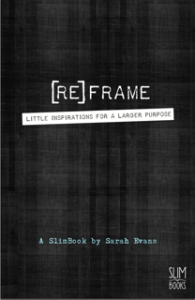 SE: In the last two years I was approached about writing a few different books, mostly related to public relations and social media. Going through the proposal process, I realized those weren’t topics I wanted to write books about–because it’s already been done. I decided to wait. I would write a book if and when there was something I was passionate about. [RE]FRAME: Little Inspirations For A Larger Purpose is one part personal journey and another part prescriptive steps to help people reconnect to their purpose. It reminds us all that in order to achieve something, you must first do. I’m kind of the queen of stating the obvious, but I believe sometimes it’s worth repeating.
SE: In the last two years I was approached about writing a few different books, mostly related to public relations and social media. Going through the proposal process, I realized those weren’t topics I wanted to write books about–because it’s already been done. I decided to wait. I would write a book if and when there was something I was passionate about. [RE]FRAME: Little Inspirations For A Larger Purpose is one part personal journey and another part prescriptive steps to help people reconnect to their purpose. It reminds us all that in order to achieve something, you must first do. I’m kind of the queen of stating the obvious, but I believe sometimes it’s worth repeating.
I specifically chose to work with the SlimBooks (@SlimBooks). team. Based on my experience, publishers tell writers books need to have a certain “width” in order to compete in a specific category. If a book you wrote gets to a publisher and it doesn’t meet a required page length you will be forced to write additional content regardless of whether or not the book needs it. It’s maddening. My writing style is informal and fits the “short and sweet” category quite nicely. I will not string together an endless list of adjectives for the sake of page length.
RS: Where did the inspiration come from?
SE: This is truly ten years of knowledge gleaned from mentors, experiences, family, etc… I used to jot down learning moments on post its or electronic notes and tweets and one day I realized I created quite a bit of content. When the co-founders of SlimBooks approached me about being on their advisory board, I realized this was the publisher I wanted to work with and this was the time to write the book I had waiting within.
RS: What will readers get from reading your book?
SE: I wrote [RE]FRAME with the philosophy that less is more. Each chapter averages one-and-a-half-pages making it a quick read for those with big ideas and little time. [RE]FRAME is one part personal journey and another part prescriptive steps to help people reconnect to their purpose. It reminds us all that in order to achieve something, you must first do. Whether you’re getting ready to graduate college or are at a crossroads in your career, it’s my hope that [RE]FRAME offers you that extra boost to keep you going.
RS: What are the images on each page?
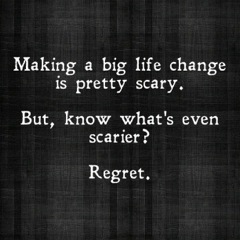
SE: Each page is paired with a motivational image called an emoti-quote, perfect for sharing or posting on your favorite social networks. You can view a few emoti-quote teasers on Instagram or Pinterest. Of course, there’s Facebook page for that, too.
RS: How would you describe this book in three sentences or less?
SE: Sometimes you need a shot in the arm, and sometimes you need a kick in the pants. [RE]FRAME is a little bit of both, providing daily inspiration and advice for those times when you’re tackling a project that seems bigger than you are.







September 10, 2012
Lisa Haneberg on Never-Ending New Beginnings
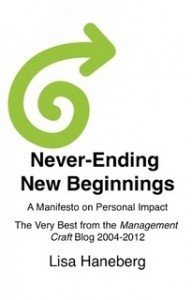 I first met Lisa Haneberg probably about eight years ago and since then I have read a number of books from her. I have also read probably hundreds of blog posts. So, I was excited to see a collection of her blog posts compiled into a book. The book is called “Never-Ending New Beginnings” and it is awesome. I had an opportunity to talk to Lisa about the book, blogging and beyond. Here is the quick interview
I first met Lisa Haneberg probably about eight years ago and since then I have read a number of books from her. I have also read probably hundreds of blog posts. So, I was excited to see a collection of her blog posts compiled into a book. The book is called “Never-Ending New Beginnings” and it is awesome. I had an opportunity to talk to Lisa about the book, blogging and beyond. Here is the quick interview
RS: Tell us a bit about the book. Why the title?
LH: Never-Ending New Beginnings is a collection of my very best blog posts from Management Craft. Because it contains only the best 69 posts, I think people will like it a lot. The title came after I assembled the collection because I noticed that the underlying theme of most of the posts was personal reinvention.
RS: Lisa – What is your goal with this book? What difference do you hope it will make?
LH: Breakthroughs happen when something shifts in our thinking and we take the opportunity to act differently. So I hope that these posts serve as catalysts and that readers find the seed of a germ of an idea that will help nudge them forward. The selection criteria I used included that the post had to have the potential to be wildly catalytic. I passed on many very good posts that did not meet this specific criteria. The result, I hope, is a very buzzy book.
RS: What has blogging done for you?
LH: I have been blogging for eight years and I feel that it has kept me on the learning path. Blogging keeps me fresh and engaged. I am sure I have learned more from my blog than it has taught others. I recommend blogging to anyone who loves to learn and explore.
RS: What do you think is the key to great management?
LH: The essence of management – or its prime goal – is to help people do their best work in the service of the organization’s goals. So the key is to spend time in ways that help people do their best work. If you ask people what their manager could do that would best help them do their best work, they will tell you things like: provide a challenge, involve them, empower them, remove barriers, be a partner, and let me do work that matters.
You write a lot about generating breakthroughs. What advice would you give to someone who feels stuck?

Several years ago I wrote a book called Two Weeks to a Breakthrough. In it, I offered something that I call the daily practice. It is a simple way to get into focused action. When people are stuck it is usually because they are either not focused, not in action, or both. The daily practice goes like this and it works – I promise: every day tell two people about your goal, make two requests that move your goal forward, and take two actions that serve your goal. These requests and actions can be small or gigantic. Start small if you like. Breakthroughs happen when you are focused and in action – a little every day.
Raj, you are a great example of this – you make so many new things happen and I think it is because you are focused, you know how to make win-win requests and you stay in action. Bravo to you!
RS: Thanks for the kind words, Lisa and also THANKS for generously sharing your insights.







September 9, 2012
The Curious Case of Missing Option Three
I have been teaching at the Founders Institute for a number of years and have enjoyed every moment of my association with FI.
“Hot seats” are a standard fixture in every session at FI. This is where a founder gives a 3-minute pitch to the group that includes a set of teachers and mentors. Immediately following that teachers and mentors rate the pitch on a scale of 1-5 and provide some feedback. The first couple of years, the rating system had numbers from 1 to 5. The last year was a big change and the number of three was removed from the options available to the teachers and mentors.
Sitting on the Fence
Choosing number three as a rating is really a cop-out. Several teachers and mentors (including me) would pick that as an option sometimes for various reasons. It was definitely the safe option – an option where one could sit on the fence. This was a place where you could not go wrong – if the founder made progress, you could say you were on the higher end of three and if the founder didn’t make progress, you could say you were on the lower end of three – whatever. Basically, you had an option to come out unscathed irrespective of what happened next.
Taking a Stand
Removing the option of choosing three forced everyone to take a stand – a clear stand on whether you like what you hear or not. Sitting on the fence is not an option. Choosing a two would send a message and choosing a four would send a very different message. Removing option three was a brilliant move by Adeo Ressi (founder of FI) to completely eliminate a “cop out” choice.
Beyond Hot Seats
This concept has wide ranging applications way beyond rating pitches during hot seats. Every time you ask for feedback of any kind, it is better to remove the “cop out” choice. It really doesn’t help if you get a three as a rating for anything. You don’t know what is being said. You don’t know whether they are happy or sad or they are just trying to be nice and polite. It is better to know the real feedback than to be in the fantasy world that everything is just great.
Have a great weekend.







Rajesh Setty's Blog
- Rajesh Setty's profile
- 6 followers





